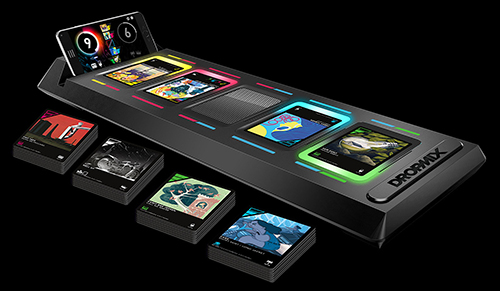Toy and board game company Hasbro and Harmonix Music Systems released a Near Field Communication (NFC) RFID-enabled board game DropMix last year, and are now considering other technology-enhanced games like it. DropMix serves as a cross between video or digital gaming and card or board games of days gone by.
Harmonix makes such music-based gaming systems as Rock Band. The company began working with Hasbro in late 2016 to develop an alternative to video games that employs old-fashioned board play, with its relatively more sociable and active form of engagement.
The DropMix system uses Harmonix’s music-mixing software, leveraging tags and readers with built-in passive 13.56 MHz ICODE chips from NXP Semiconductors, using an RFID standard that is neither the traditional 14443 or 15693. A reader in the game board captures card tag ID numbers, then updates a music mix that is forwarded to a player’s smartphone or tablet via a Bluetooth connection.
Paragon-ID provides the cards, which it manufactures, prints and encodes at high speeds, according to game requirements. It’s a market first, according to Alexander Rensink, NXP’s business-segment manager: a game that employs NFC, Bluetooth, apps and traditional physical playing cards and board.
Hasbro has been seeking games that can serve as a bridge to the digital world, while still using the traditional props of a board game—cards and an actual game board. The company has been working with Harmonix Music Systems to create a solution.
“We’ve used camera tech for other projects, like Dance Central, and we explored using optical recognition in early prototypes for this project” as well, says Jonathan Mintz, Harmonix’s DropMix creative lead. However, he adds, RFID quickly emerged as the best technology choice for DropMix. “It provided the speed we needed, while working in any lighting condition, with minimal setup.” Since the game doesn’t depend on optics, he notes, the technology can recognize a single card or a stack of cards in any lighting.
To begin the game, users must first download the DropMix app from the Apple App Store or Google Play, then place the app-running device within Bluetooth range of the playing board. Each of the 60 playing cards has a built-in NFC RFID tag with a unique ID number linked to a specific song and element within that song (guitar, beat, vocals or supporting instruments). The game strives to offer the greatest hits in the R&B, pop, dance, indie, country, rock and hip-hop genres. Users can buy more NFC-enabled cards in the form of booster packs to update or expand their music at any given time.
The board has a built-in reader containing an NXP chip, as well as antennas to capture the IDs of the card tags, as the cards are placed in one of five specific spaces on the board; each has its own dedicated antenna. The reader then forwards the tags’ IDs to a phone running the DropMix app, prompting the playing of a song mix according to the NFC tag reads. The first card placed on the board launches the song’s pace and key, and the additional cards then blend with it to create the music mix. Players can simply create music in freestyle mode, or set up competitive games.
To meet the high-volume needs for a consumer product, Paragon-ID needed to produce a large volume of high-quality cards, says Bertrand Brault, the company’s marketing and business-development director. Playing cards can be printed and encoded at a rate of up to 15,000 units per hour, he says. The firm has been producing cards since May 2017, following nine months of development.
The game itself required months of engineering to ensure it could operate seamlessly. “Our primary goal with DropMix was to provide an accessible, engaging musical experience to our players,” Mintz says. “So, when looking at different options for tech, we knew that we needed to have fast response time with the potential to include an endless variety of distinct content.”
Harmonix then intensively tested the game to ensure that it would work as intended. “We did a ton of playtesting,” Mintz states, “to ensure that not only could players understand how the cards create and change the music, but also how to use the cards and board in the flow of gameplay.”
Since the system was released, Mintz reports, “We’re thrilled with how the game turned out. Watching that moment where players play that first card and realize how they’re shaping the music is amazing.” Paragon-ID has already produced cards in the multi-millions, Brault adds, using high-speed producing and encoding methods.
According to NXP, more games like DropMix, using NFC technology, are likely to be released during the coming years. “What we’re seeing now is the cost levels driven down to the point where you can fit NFC technology into consumer products,” Rensink says. In fact, he adds, “Gaming is an area where we’ve become very active.”
Even beyond games, Rensink says, as the technology evolves and applications proliferate (along with the release of open NFC functionality in new iOS devices), “There’s an enormous opportunity to make every consumer product smart,” by tagging a particular product or item and connecting it directly to its tag via an NFC-enabled phone or other device.



